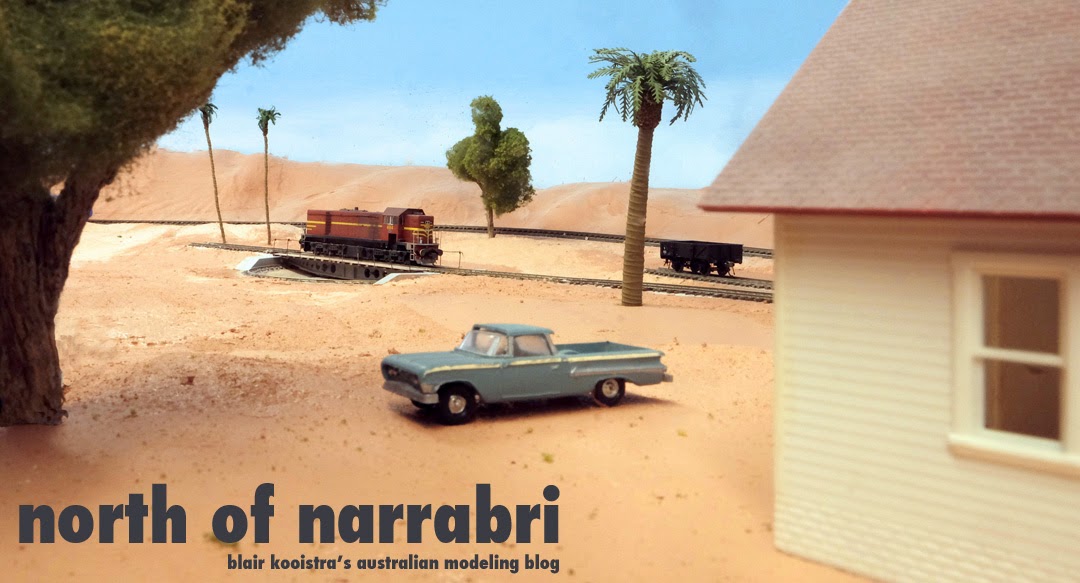 Looking down-bound (towards end of branch) at east end of Wee Waa, 1981. Photo from flickr, courtesy opsbooks,used with permission.Ice and snow in Fort Worth--brrr.
Looking down-bound (towards end of branch) at east end of Wee Waa, 1981. Photo from flickr, courtesy opsbooks,used with permission.Ice and snow in Fort Worth--brrr. Quite extraordinary, actually, though last year we got one big storm with 14" of snow. The past week has brought us three blasts of winter--ice, a bit of snow, and another shot of ice. It's been enough to keep me inside and brought me back to working on the railway! Quite a change from summer in Australia, where it's quite toasty warm and the sun beats down when there isn't a bushfire or cyclone or torrential flood to deal with.
Ah yes, Australia. And specifically, oh little town of Wee Waa.
I want to get at least one "scene" relatively completed in the next couple of months, so bit off the smallest chunk I could, the 9-feet of benchwork in the upstairs office containing the branchline town of Wee Waa.
Most of the track had been in place for over a year, but I'd had a couple of points left to build and wire to truly finish the trackwork off. And in studying the prototype plan a bit more closely, I decided to add a crossover off the loop in order to allow shunting the goods shed without disturbing the load bank. Such an extravagant use of points would be considered "unprototypical" in the states, where railroads do whatever they can to avoid maintaining trackage like extra crossovers and the like. But that's part of the point of a Yank modeling Australia, isn't it? To build a railway that clearly isn't the same as Bob Santa Fe or Jerry Union Pacific's pike.
 Newly-revised Wee Waa.
Newly-revised Wee Waa.All that's left is a few feeder wires and adding the point control rods and I'll be ready to get crackin' with scenery, a dash of paint on the backdrop, and finishing the goods shed, station and load bank before tackling the rest of the structures: there's a grain silo, the water tank by the level crossing, and a cement flood control weir where tracks pass through a levee on the up side of town, in deference to the often-flooding Namoi river.
I'm looking forward to getting the wiring and point rodding in tomorrow, so I can fire up the DCC and run a short goods train into town and give this track arrangement a test drive!
For a little vignette of what this part of the Walgett branch looked like in 1974, check out this link to a
travelogue by Brian Ayling. Cool stuff.
And thanks to John at
collectingbooksandmagazines.com for permission to use the photo at the top of this posting of Wee Waa. Wonderful view, eh? He's got a ton of other great photos of Australian life in his
flickr account, which I can't recommend highly enough.
The Roster GrowethLast month, I became the quite happy recipient of eight Austrains WHX grain wagons, which are all new and shiny silver and quite noticeable on the layout. Once I fire up the Iwata brush, I hope to put an end to that! That was followed by six nice RACE containers by SDS--perfect for the OCX/OCY flats I constructed in 2010.
It's been about a year since I splurged on much equipment for the railroad. Now that the WHX's are safely aboard, I'm now waiting the postman to bring one more Train-O 44 Class, and a few resin kits from
Ian Ratcliffe's IDR product line--a pair of KF flat wagons, a KHG brakevan, and a MLV louvre van for the mail train.
And then it could get ugly (or, rather,
expensive). There's the Train-o MHG brake vans next month, then a pack of Austrains FS/BS/BSR coaches for the mail train after that, and more RACE containers to get from On Track and SDS, and a pack of SDS's OCY's, and, oh my, at least three packs of those
tasty Tulloch tanks from SDS as well.
Like I said. It's going to get
ugly. But you either have to get them now, or miss them (or end up paying high $$ from some clown on e-bay). Thank God the 48's aren't here now, or Eureka's DEB sets! It's going to be tough enough to scrimp the $$ together for airfare down under early 2012 without all these models. I'm going to have to pray for more snow and start shoveling driveways for my neighbors!



















